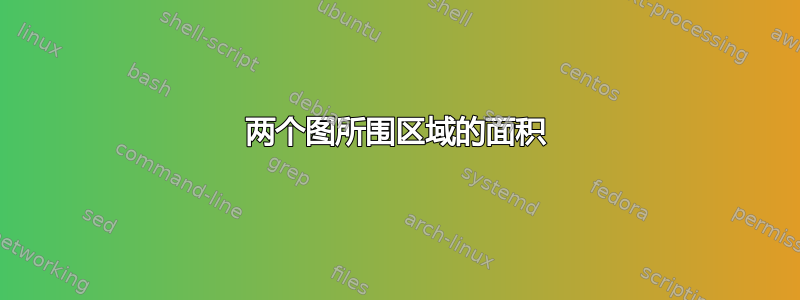
我正在寻找下面更专业的程序。我相信我可以命名曲线并让 TiKz 计算交点,而不是用笔和纸找到它们。我承认在这个构造上花了一个小时。抱歉冗余或多余的评论。
\documentclass{article}
\usepackage{tikz}
\begin{document}
\begin{minipage}{.3\textwidth}
\begin{center}
\begin{tikzpicture}[scale=.5,declare function={g(\x)=(\x-1)^(2)+1;},declare
function={f(\x)=.5*\x+4;}]
\draw[fill=orange!40!white,dashed]
plot[domain=-.6375:3.137,samples=167,variable=\x] ({\x},{f(\x)})
-- (3.137,-2) -| cycle;
\draw[fill=white,dashed]
plot[domain=-.6375:3.137,samples=167,variable=\x] ({\x},{g(\x)})
-- (3.137,-2) -| cycle;
\draw[domain=-1:3.8,smooth,variable=\x,red,<->,thick] plot ({\x},{g(\x)});
\draw[domain=-1.4:4.4,smooth,variable=\x,blue,<->,thick] plot ({\x},
{f(\x)});
\draw[fill] (-.6375,{g(-.6375)}) circle (4pt);
\draw[fill] (-.6375,-2) circle (4pt);
\draw[fill] (3.137,{g(3.137)}) circle (4pt);
\draw[fill] (3.137,-2) circle (4pt);
%\draw[domain=-3:-1,smooth,variable=\x,red,<-,thick] plot ({\x},{g(\x)});
\draw[dashed] (-.6375,{g(-.6375)})--(-.6375,-2) node[below] {$a$};
\draw[dashed] (3.137,{g(3.137)})--(3.137,-2) node[below] {$b$};
\draw (-2.25,-2)--(5,-2);
\node at (3.8,{g(3.8)}) [right,text=red] {$g$};
\node at (4.4,{f(4.4)}) [right,text=blue] {$f$};
\node at (1,3) [] {$A$};
\end{tikzpicture}
\end{center}
\end{minipage}
\hspace{1cm}
\begin{minipage}{.3\textwidth}
\begin{center}
\begin{tikzpicture}[scale=.5,declare function={g(\x)=(\x-1)^(2)+1;},declare
function={f(\x)=.5*\x+4;}]
\draw[fill=orange!40!white]
plot[domain=-.6375:3.137,samples=167,variable=\x] ({\x},{f(\x)})
-- (3.137,-2) -| cycle;
%\draw[fill=white,dashed]
% plot[domain=-.6375:3.137,samples=167,variable=\x] ({\x},{g(\x)})
% -- (3.137,-2) -| cycle;
%\draw[domain=-1:3.8,smooth,variable=\x,red,<->,thick] plot ({\x},{g(\x)});
\draw[domain=-1.4:4.4,smooth,variable=\x,blue,<->,thick] plot ({\x},
{f(\x)});
\draw[fill] (-.6375,{g(-.6375)}) circle (4pt);
\draw[fill] (-.6375,-2) circle (4pt);
\draw[fill] (3.137,{g(3.137)}) circle (4pt);
\draw[fill] (3.137,-2) circle (4pt);
%\draw[domain=-3:-1,smooth,variable=\x,red,<-,thick] plot ({\x},{g(\x)});
\draw[] (-.6375,{g(-.6375)})--(-.6375,-2) node[below] {$a$};
\draw[] (3.137,{g(3.137)})--(3.137,-2) node[below] {$b$};
\draw (-2.25,-2)--(5,-2);
\node at (3.8,{g(3.8)}) [right,text=white] {$g$};
\node at (4.4,{f(4.4)}) [right,text=blue] {$f$};
\node at (1,1) [] {$A_{2}$};
\end{tikzpicture}
\end{center}
\end{minipage}
\hspace{1cm}
\begin{minipage}{.3\textwidth}
\begin{center}
\begin{tikzpicture}[scale=.5,declare function={g(\x)=(\x-1)^(2)+1;},declare
function={f(\x)=.5*\x+4;}]
%\draw[fill=white]
% plot[domain=-.6375:3.137,samples=167,variable=\x] ({\x},{f(\x)})
% -- (3.137,-2) -| cycle;
\draw[fill=orange!40!white,dashed]
plot[domain=-.6375:3.137,samples=167,variable=\x] ({\x},{g(\x)})
-- (3.137,-2) -| cycle;
\draw[domain=-1:3.8,smooth,variable=\x,red,<->,thick] plot ({\x},{g(\x)});
%\draw[domain=-1.4:4.4,smooth,variable=\x,blue,<->,thick] plot ({\x},
{f(\x)});
\draw[fill] (-.6375,{g(-.6375)}) circle (4pt);
\draw[fill] (-.6375,-2) circle (4pt);
\draw[fill] (3.137,{g(3.137)}) circle (4pt);
\draw[fill] (3.137,-2) circle (4pt);
%\draw[domain=-3:-1,smooth,variable=\x,red,<-,thick] plot ({\x},{g(\x)});
\draw[] (-.6375,{g(-.6375)})--(-.6375,-2) node[below] {$a$};
\draw[] (3.137,{g(3.137)})--(3.137,-2) node[below] {$b$};
\draw (-2.25,-2)--(5,-2);
\node at (3.8,{g(3.8)}) [right,text=red] {$g$};
%\node at (4.4,{f(4.4)}) [right,text=] {$f$};
\node at (1,1) [below] {$A_{1}$};
\end{tikzpicture}
\end{center}
\end{minipage}
\end{document}
输出:
答案1
pgfplots这是一个加载和使用该库的提案fillbetween,但只有 Ti钾Z 语法。您无需手动计算任何交点。
\documentclass{article}
\usepackage{tikz}
\usepackage{pgfplots}
\pgfplotsset{compat=1.16}
\usepgfplotslibrary{fillbetween}
\usetikzlibrary{backgrounds}
\begin{document}
\begin{minipage}{.3\textwidth}
\centering
\begin{tikzpicture}[scale=.5,declare function={g(\x)=(\x-1)^(2)+1;
f(\x)=.5*\x+4;}]
\draw[domain=-1.4:4.4,smooth,variable=\x,blue,<->,thick,name path=f1] plot ({\x},
{f(\x)});
\draw[domain=-1:3.8,smooth,variable=\x,red,<->,thick,name path=g1] plot ({\x},{g(\x)});
\begin{scope}[on background layer]
\path[fill=orange!40!white,%blue,very thick,
intersection segments={of=f1 and g1,sequence={A1 -- B1[reverse]}}];
\end{scope}
\draw[fill,name intersections={of=f1 and g1,name=I1}]
(I1-1) circle (4pt) (I1-2) circle (4pt)
(I1-1|-0,-2) circle (4pt) (I1-2|-0,-2) circle (4pt);
\draw[dashed] (I1-1)--(I1-1|-0,-2) node[below] {$\mathstrut a$};
\draw[dashed] (I1-2)--(I1-2|-0,-2) node[below] {$\mathstrut b$};
\draw (-2.25,-2)--(5,-2);
\node at (3.8,{g(3.8)}) [right,text=red] {$g$};
\node at (4.4,{f(4.4)}) [right,text=blue] {$f$};
\node at (1,3) {$A$};
\end{tikzpicture}
\end{minipage}
\hspace{1cm}
\begin{minipage}{.3\textwidth}
\centering
\begin{tikzpicture}[scale=.5,declare function={g(\x)=(\x-1)^(2)+1;
f(\x)=.5*\x+4;}]
\draw[domain=-1.4:4.4,smooth,variable=\x,blue,<->,thick,name path=f2] plot ({\x},
{f(\x)});
\path[domain=-1:3.8,smooth,variable=\x,<->,name path=g2] plot ({\x},{g(\x)});
\draw[fill,name intersections={of=f2 and g2,name=I2}]
(I2-1) circle (4pt) (I2-2) circle (4pt)
(I2-1|-0,-2) circle (4pt) (I2-2|-0,-2) circle (4pt);
\begin{scope}[on background layer]
\path[fill=orange!40!white]
(I2-1|-0,-2) -- (I2-1) -- (I2-2) -- (I2-2|-0,-2);
\end{scope}
\draw (I2-1)--(I2-1|-0,-2) node[below] {$\mathstrut a$};
\draw (I2-2)--(I2-2|-0,-2) node[below] {$\mathstrut b$};
\draw (-2.25,-2)--(5,-2);
\node at (3.8,{g(3.8)}) [right,text=white] {$g$};
\node at (4.4,{f(4.4)}) [right,text=blue] {$f$};
\node at (1,1) [] {$A_{2}$};
\end{tikzpicture}
\end{minipage}
\hspace{1cm}
\begin{minipage}{.3\textwidth}
\centering
\begin{tikzpicture}[scale=.5,declare function={g(\x)=(\x-1)^(2)+1;
f(\x)=.5*\x+4;}]
\path[domain=-1.4:4.4,smooth,variable=\x,name path=f3] plot ({\x},
{f(\x)});
\draw[domain=-1:3.8,smooth,variable=\x,red,<->,thick,name path=g3] plot ({\x},{g(\x)});
\draw[fill,name intersections={of=f3 and g3,name=I3}]
(I3-1) circle (4pt) (I3-2) circle (4pt)
(I3-1|-0,-2) circle (4pt) (I3-2|-0,-2) circle (4pt);
\path[name path=aux] (I3-1) -- (I3-1|-0,-2) -- (I3-2|-0,-2) -- (I3-2) -- cycle;
\begin{scope}[on background layer]
\path[fill=orange!40!white,%blue,very thick,
intersection segments={of=aux and g3,sequence={A0[reverse] -- B1}}];
\end{scope}
\draw (I3-1)--(I3-1|-0,-2) node[below] {$\mathstrut a$};
\draw (I3-2)--(I3-2|-0,-2) node[below] {$\mathstrut b$};
\draw (-2.25,-2)--(5,-2);
\node at (3.8,{g(3.8)}) [right,text=red] {$g$};
\node at (1,1) [below] {$A_{1}$};
\end{tikzpicture}
\end{minipage}
\end{document}




